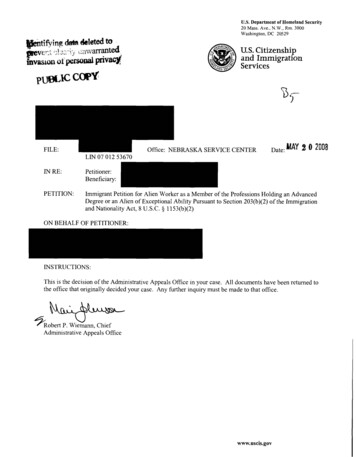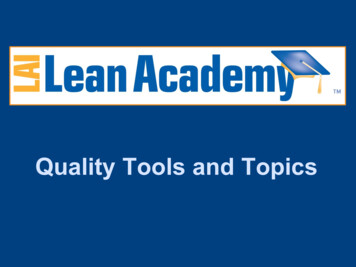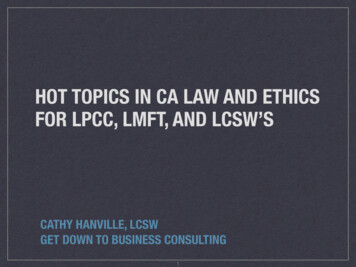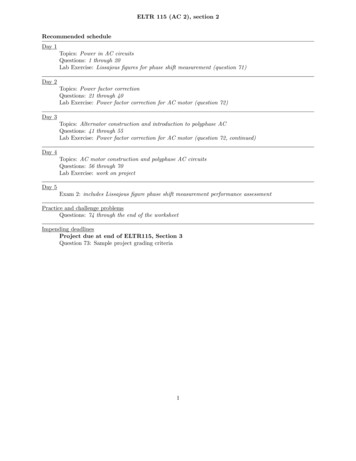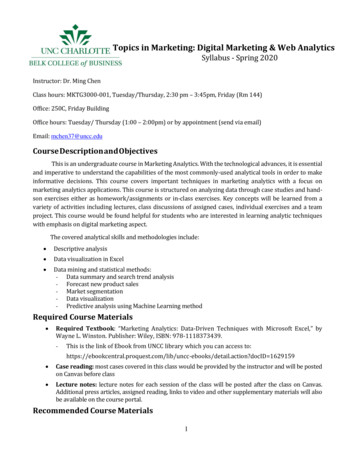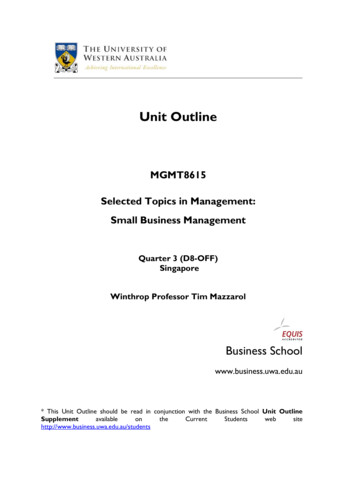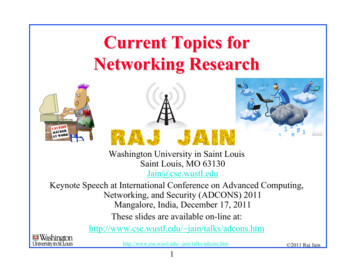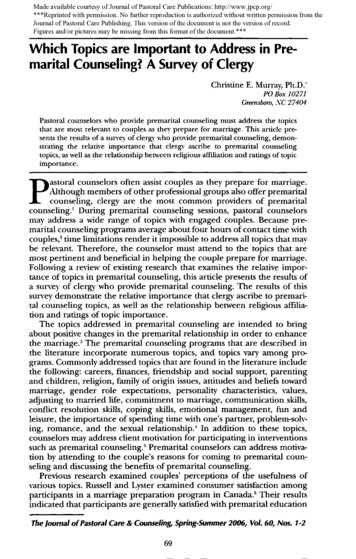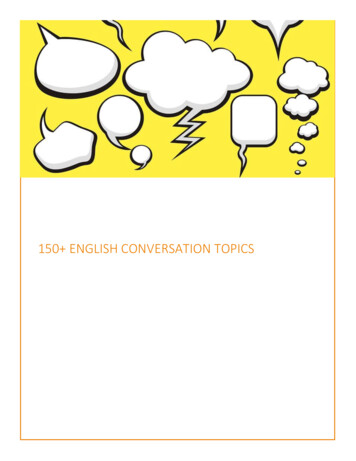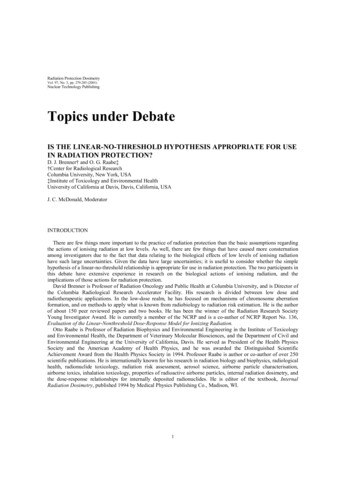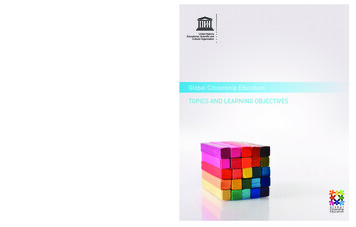
Transcription
United NationsEducational, Scientific andCultural OrganizationGlobal citizenship education aims to betransformative, building the knowledge,skills, values and attitudes to enablelearners to contribute to a more inclusive, justand peaceful world. This publication, titledGlobal Citizenship Education: Topics and learningobjectives, is the first pedagogical guidancefrom UNESCO on Global Citizenship Education.It presents suggestions for translating GlobalCitizenship Education concepts into practical andage-specific topics and learning objectives in a waythat allows for adaptation to local contexts. It isintended as a resource for educators, curriculumdevelopers, trainers as well as policy-makers,but it will also be useful for other educationstakeholders working in non-formal and informalsettings.Global Citizenship EducationTOPICS AND LEARNING OBJECTIVESFor further informationplease contact: gced@unesco.orgor visit: ucationWith the support ofEducationSectorUnited NationsEducational, Scientific andCultural Organization9 789231 001024
Published in 2015 by the United Nations Educational, Scientific and Cultural Organization,7, place de Fontenoy, 75352 Paris 07 SP, France UNESCO 2015ISBN 978-92-3-100102-4This publication is available in Open Access under the Attribution-ShareAlike 3.0 IGO (CCBY-SA 3.0 IGO) license /). By using thecontent of this publication, the users accept to be bound by the terms of use of the UNESCOOpen Access Repository a-en).The designations employed and the presentation of material throughout this publicationdo not imply the expression of any opinion whatsoever on the part of UNESCO concerningthe legal status of any country, territory, city or area or of its authorities, or concerning thedelimitation of its frontiers or boundaries.The ideas and opinions expressed in this publication are those of the authors; they are notnecessarily those of UNESCO and do not commit the Organization.Photo cover credit: Shutterstock/mama miaCredits: pp.12-13, p.20, pp.44-45 Shutterstock/Danylo StaroshchukGraphic design: Aurelia MazoyerPrinted by UNESCOPrinted in France
Global Citizenship EducationTOPICS AND LEARNING OBJECTIVES
Table of contentsForeword7Acknowledgements9List of acronyms111. Introduction131.1 What is global citizenship education?1.2 How was this guidance developed?1.3 Who is this guidance for and how can it be used?2. The guidance – learning contents of global citizenship education2.1 Domains2.2 Outcomes2.3 Attributes2.4 Topics2.5 Objectives2.6 Key words2.7 Guidance matrix3. Implementing global citizenship education3.1 How to integrate it in education systems3.2 How to deliver it in the classroom3.3 How to assess learning outcomesAnnexesAnnex 1: Selected online practices and resourcesAnnex 2: BibliographyAnnex 3: List of field testing 3
List of tablesTable A: Overall guidance28Table B: Topics and elaborated learning objectives30B.1 Topic: Local, national and global systems and structures32B.2 Topic: Issues affecting interaction and connectednessof communities at local, national and global levels33B.3 Topic: Underlying assumptions and power dynamics34B.4 Topic: Different levels of identity35B.5 Topic: Different communities people belong to and how these are connected36B.6 Topic: Difference and respect for diversity37B.7 Topic: Actions that can be taken individually and collectively38B.8 Topic: Ethically responsible behaviour39B.9 Topic: Getting engaged and taking action40Table C: Key words42List of boxesBox 1: Core conceptual dimensions of global citizenship education15Box 2: How to use the pedagogical guidance at country level18Box 3: Key learning outcomes22Box 4: Key learner attributes23Box 5: Topics255
ForewordUNESCO has promoted global citizenship education since the launch of the UNSecretary-General’s Global Education First Initiative (GEFI) in 2012, which made fosteringglobal citizenship one of its three education priorities.This publication, titled Global Citizenship Education: Topics and learning objectives, is thefirst pedagogical guidance from UNESCO on global citizenship education. It is the resultof an extensive research and consultation process with experts from different parts ofthe world. This guidance draws on the UNESCO publication Global Citizenship Education:Preparing learners for the challenges of the 21st century and the outcomes of three keyUNESCO events on global citizenship education: the Technical Consultation on GlobalCitizenship Education (September 2013), as well as the First and Second UNESCO Fora onGlobal Citizenship Education, organized in December 2013 and January 2015 respectively.Before it was finalized, the guidance was field-tested by education stakeholders in selectedcountries in all regions to ensure its relevance in different geographical and socio-culturalcontexts.Following the foundational work of UNESCO to clarify the conceptual underpinnings ofglobal citizenship education and provide policy and programmatic directions, this documenthas been developed in response to the needs of Member States for overall guidance onintegrating global citizenship education in their education systems. It presents suggestionsfor translating global citizenship education concepts into practical and age-specific topicsand learning objectives in a way that allows for adaptation to local contexts. It is intendedas a resource for educators, curriculum developers, trainers as well as policy-makers, butit will also be useful for other education stakeholders working in non-formal and informalsettings.At a time when the international community is urged to define actions to promote peace,well-being, prosperity and sustainability, this new UNESCO document offers guidance tohelp Member States ensure that learners of all ages and backgrounds can develop intoinformed, critically literate, socially-connected, ethical and engaged global citizens.Qian Tang, Ph. D.Assistant Director-General for Education7
AcknowledgementsThis pedagogical guidance titled Global Citizenship Education: Topics and learning objectiveswas commissioned by the United Nations Educational, Scientific and Cultural Organization(UNESCO). Its preparation, under the overall guidance of Soo Hyang Choi, Director of the Divisionof Teaching, Learning and Content at UNESCO, was coordinated by Chris Castle, Lydia Ruprechtand Theophania Chavatzia in the Section of Health and Global Citizenship Education.Dina Kiwan, Associate Professor at the American University of Beirut, and Mark Evans, AssociateProfessor at the University of Toronto, were contributing authors of this document. Kathy Attawelland Jane Kalista, independent consultants, edited various drafts.UNESCO convened the meeting of the Experts Advisory Group (EAG) on Global CitizenshipEducation (GCED) (Paris, June 2014), and would like to express its gratitude to all those whoparticipated in the meetings and/or provided comments on various drafts: Abbie Raikes, UNESCOHQ; Albert Motivans, UIS; Alexander Leicht, UNESCO HQ; Carolina Ibarra, Universidad de los Andes,Colombia; Dakmara Georgescu, UNESCO Beirut; Carolee Buckler, UNESCO HQ; Dirk Hastedt,IEA; Felisa Tibbitts, Executive Director and a Founder of the Human Rights Education Associates;Gwang-Chol Chang, UNESCO Bangkok; Hyojeong Kim, APCEIU; Injairu Kulundu, Activate! ChangeDrivers; Jeongmin Eom, APCEIU; Ji Min Cho, KICE; Jinhee Kim, KEDI; Jun Morohashi, UNESCOHaiti; Kate Anderson Simons, LMTF, Brookings; Koji Miyamoto, OECD; Miguel Silva, North-SouthCentre of the Council of Europe; Muhammad Faour, York University; Onemus Kiminza, Ministryof Education, Kenya; Ralph Carstens, IEA; Stephanie Knox Cubbon, Teachers without Borders;Tony Jenkins, University of Toledo; Werner Wintersteiner, Klagenfurt University; Wing-On Lee,National Institute of Education, Singapore; Yolanda Leyvas, National Institute for the Evaluation ofEducation, Mexico.Written comments and contributions were also gratefully received from: Akemi Yonemura,UNESCO Dakar; Aliénor Salmon, UNESCO Bangkok; Amalia Miranda Serrano, UNESCOBangkok; Amina Hamshari, UNESCO HQ; Anantha Kumar Duraiappah, MGIEP; Christina VonFurstenberg, UNESCO HQ; Hegazi Idris Ibrahim, UNESCO Beirut; Hugue Charnie NgandeuNgatta, UNESCO HQ; Musafir Shankar, MGIEP; Nabila Jamshed, MGIEP; Opertti Renato, IBE.Written comments were received from Margaret Sinclair, PEIC, as well as oral contributionsfrom other participants of the Second UNESCO Forum on Global Citizenship Education(28-30 January 2015).UNESCO would also like to thank those who participated in the field-testing process for their usefulfeedback. These include APCEIU, for coordinating feedback from Korean teachers; Fadi Yarak,Ministry of Education and Higher Education in Lebanon, for ensuring feedback from ministryofficials, as well as Marie-Christine Lecompte, Olivia Flores and Rosie Agoi, ASPnet Coordinatorsin Canada, Mexico and Uganda respectively, together with the schools, teachers and students inthese countries that participated in the field testing.Finally, thanks are offered to Chantal Lyard, who provided editorial support, Aurélia Mazoyer whoundertook the design and layout, Martin Wickenden and Nanna Engebretsen, who provided liaisonsupport for the production of this document.9
List of acronymsAPCEIUAsia-Pacific Centre of Education for International UnderstandingASPnetAssociated Schools Project Network (UNESCO)EAGExperts Advisory GroupECOWASEconomic Community of West African StatesESCEducation for Social CohesionESDEducation for Sustainable DevelopmentGCEDGlobal Citizenship EducationGEFIGlobal Education First Initiative (of the UN Secretary-General)GIZDeutsche Gesellschaft für Internationale Zusammenarbeit GmbHHIV/AIDSHuman Immunodeficiency Virus/ Acquired Immune Deficiency SyndromeHQHeadquartersIBEInternational Bureau of Education (UNESCO)ICTInformation and Communication TechnologyIEAInternational Association for the Evaluation of Educational AchievementKEDIKorean Educational Development InstituteKICEKorea Institute for Curriculum and EvaluationLMTFLearning Metrics Task ForceLTLTLearning to Live TogetherMGIEPMahatma Gandhi Institute of Education for Peace and Sustainable DevelopmentNGONon-Governmental OrganizationOHCHROffice of the United Nations High Commissioner for Human RightsOSCE/ODIHROrganization for Security and Co-operation in Europe/Officefor Democratic Institutions and Human RightsPEICProtect Education in Insecurity and ConflictSDGsSustainable Development GoalsUISUNESCO Institute for StatisticsUNUnited NationsUKUnited KingdomUNEPUnited Nations Environment ProgrammeUNESCOUnited Nations Educational, Scientific and Cultural OrganizationUNICEFUnited Nations Children’s Fund11
12
1Introduction13
1.1 What is global citizenship education?“Education gives us a profound understanding that we are tied together as citizensof the global community, and that our challenges are interconnected.”Ban Ki-moon, UN Secretary-GeneralThe concept of citizenship has evolved over time. Historically, citizenship did not extendto all – for example, only men or property owners were eligible to be citizens.1 During thepast century, there has been a gradual movement towards a more inclusive understandingof citizenship, influenced by the development of civil, political and social rights.2 Currentperspectives on national citizenship vary between countries, reflecting differences inpolitical and historical context, among other factors.An increasingly globalised world has raised questions about what constitutes meaningfulcitizenship as well as about its global dimensions. Although the notion of citizenship thatgoes beyond the nation state is not new, changes in the global context – for example,the establishment of international conventions and treaties, the growth of transnationalorganisations, corporations and civil society movements, and the development of internationalhuman rights frameworks – have significant implications for global citizenship. It has to beacknowledged that there are differing perspectives about the concept of global citizenshipincluding, such as the extent to which it extends and complements traditional citizenship,defined in terms of the nation state, or the extent to which it competes with it.Global citizenship3 refers to a sense of belonging to a broader community and commonhumanity. It emphasises political, economic, social and cultural interdependency andinterconnectedness between the local, the national and the global.Growing interest in global citizenship has resulted in increased attention to the globaldimension in citizenship education as well, and the implications for policy, curricula, teachingand learning.4 Global citizenship education entails three core conceptual dimensions, whichare common to various definitions and interpretations of global citizenship education.These core conceptual dimensions draw on a review of literature, conceptual frameworks,approaches and curricula on global citizenship education, as well as technical consultationsand recent work in this area by UNESCO. They can serve as the basis for defining globalcitizenship education goals, learning objectives and competencies, as well as prioritiesfor assessing and evaluating learning. These core conceptual dimensions are based on,and include, aspects from all three domains of learning: cognitive, socio-emotional and123414See Heater (1990); Ichilov (1998); Isin (2009).See Marshall (1949).UNESCO (2014). Global citizenship education: Preparing learners for the challenges of the 21st century.See Albala-Bertrand (1995); Banks (2004); Merryfield (1998); Peters, Britton and Blee (2008).
behavioural. These are interrelated and are presented below, each indicating the domain oflearning they focus on most in the learning process:Box 1: Core conceptual dimensions of global citizenship educationCognitive:To acquire knowledge, understanding and critical thinking about global, regional,national and local issues and the interconnectedness and interdependency of differentcountries and populations.Socio-emotional:To have a sense of belonging to a common humanity, sharing values and responsibilities,empathy, solidarity and respect for differences and diversity.Behavioural:To act effectively and responsibly at local, national and global levels for a morepeaceful and sustainable world.Global citizenship education aims to be transformative, building the knowledge, skills,values and attitudes that learners need to be able to contribute to a more inclusive,just and peaceful world. Global citizenship education takes ‘a multifaceted approach,employing concepts and methodologies already applied in other areas, including humanrights education, peace education, education for sustainable development and educationfor international understanding’5 and aims to advance their common objectives. Globalcitizenship education applies a lifelong learning perspective, beginning from early childhoodand continuing through all levels of education and into adulthood, requiring both ‘formaland informal approaches, curricular and extracurricular interventions, and conventionaland unconventional pathways to participation’.656UNESCO (2014). Education Strategy 2014 – 2021, p.46.UNESCO (2014). Global citizenship education: Preparing learners for the challenges of the 21st century.15
Global citizenship education aims to enable learners to: develop an understanding of global governance structures, rights andresponsibilities, global issues and connections between global, national andlocal systems and processes; recognise and appreciate difference and multiple identities, e.g. culture,language, religion, gender and our common humanity, and develop skills forliving in an increasingly diverse world; develop and apply critical skills for civic literacy, e.g. critical inquiry, informationtechnology, media literacy, critical thinking, decision-making, problem solving,negotiation, peace building and personal and social responsibility; recognise and examine beliefs and values and how they influence political andsocial decision-making, perceptions about social justice and civic engagement; develop attitudes of care and empathy for others and the environment andrespect for diversity; develop values of fairness and social justice, and skills to critically analyseinequalities based on gender, socio-economic status, culture, religion, age andother issues; participate in, and contribute to, contemporary global issues at local, nationaland global levels as informed, engaged, responsible and responsive globalcitizens.Priority Gender Equality: Global citizenship education can play an important role incontributing to gender equality, which is one of the two overarching priorities of UNESCO.Global citizenship education is based on human rights, and gender equality is a basic humanright. Girls and boys learn about gendered attitudes, roles, expectations and behaviours atschool as well as at home. Global citizenship education can support gender equality throughthe development of knowledge, skills, values and attitudes that promote the equal value ofwomen and men, engender respect and enable young people to critically question genderedroles and expectations that are harmful and/or encourage gender-based discrimination andstereotyping.16
1.2 How was this guidance developed?This guidance draws on research and practice in global citizenship education. It has beeninformed by recent UNESCO publications and technical consultations in this area7 as wellas inputs provided by experts on global citizenship education and youth representatives. Thedocument was reviewed by the Experts Advisory Group (EAG), convened by UNESCO withinternal and external experts from all regions of the world in global citizenship education,transformative pedagogies, curriculum development and non-formal education. The EAGdiscussed and provided feedback on the first draft of the document during a meeting inJune 2014. Additional inputs were provided through further consultations in Septemberand October 2014. The guidance was also discussed during the Second UNESCO Forumon Global Citizenship Education (Paris, January 2015) and benefited from feedback fromparticipants.Before it was finalized, this guidance was field tested by education stakeholders, includingministry officials, curriculum developers and teachers in selected countries in every region.This is the first edition of the guidance, which is intended as a living document. Furthereditions will be produced as necessary and as we learn more from experience of implementingglobal citizenship education in different contexts. UNESCO would welcome suggestions andexamples of research and practice for future editions.7For example, Global Citizenship Education: An emerging perspective, based on the Technical Consultation on GlobalCitizenship Education (September 2013) and Global Citizenship Education: Preparing learners for the challenges of the 21stcentury, synthesizing the outcomes of the First UNESCO Forum on Global Citizenship Education (December 2013).17
1.3 Who is this guidance for and how canit be used?This guidance is intended as a resource for educators, curriculum developers, trainers aswell as policy makers. It can also be useful for other education stakeholders involved in theplanning, design and delivery of global citizenship education in the formal and non-formaleducation sectors. For example, educators can use it to improve their understanding ofglobal citizenship education and as a source of ideas for activities. Curriculum developerscan use and adapt the topics and learning objectives included in the guidance to the countrycontext and develop national curricula. Education policy makers can use the guidance toassess the role of global citizenship education and identify relevant national educationpriorities.As suggested in the graph below, this guidance is designed in a flexible way that allows forconsultation, adaptation and contextualization at country level by education providers whocan identify relevant entry points, develop detailed and concrete context-specific guidance,address delivery capacity needs and support the implementation process, in consultationwith relevant stakeholders.Box 2: How to use the pedagogical guidance at country levelGlobal Citizenship Education: Topics and learning objectives (TLOs)Contextualization of TLOs at country level by national and local stakeholders(e.g. education planners and curriculum developers and, where needed, withsupport from other partners and stakehorldersDetailed and concrete context-specific guidance developed and capacity issues addressedImplementation and use by education practitioners at various levels(e.g. national, provincial, school)The guidance is not intended to be prescriptive, but rather aims to provide a guidingframework for global citizenship education that can be easily adapted to different nationaland local contexts. It can also be used to build on existing work in related areas (e.g. civic18
education, human rights education, education for sustainable development, educationfor international understanding, or others). The suggested topics and learning objectivesincluded in this guidance are not exhaustive; these can and should be complemented bytopics and issues that are locally relevant and appropriate. Furthermore, new issues thatcontinually emerge in a rapidly changing and diverse world can be added to those includedin this guidance. Some of the topics and learning objectives included in this guidance mayalready be covered in existing education programmes. In this case, the guidance can beused as a complementary resource, or as a checklist or reference for gap analysis whenreviewing or seeking to strengthen these existing programmes.19
20
2The guidance – learning contentsof global citizenship education21
2.1 DomainsGlobal citizenship education is based on the three domains of learning – the cognitive, socioemotional and behavioural. These correspond to the four pillars of learning described in thereport ‘Learning: The Treasure Within’: Learning to know, to do, to be and to live together. Cognitive: knowledge and thinking skills necessary to better understand the world andits complexities. Socio-emotional: values, attitudes and social skills that enable learners to developaffectively, psychosocially, and physically and to enable them to live together with othersrespectfully and peacefully. Behavioural: conduct, performance, practical application and engagement.The key learning outcomes, key learner attributes, topics and learning objectives suggestedin this guidance are based on the three domains of learning mentioned above. They areinterlinked and integrated in the learning process and should not be understood as distinctlearning processes.2.2 OutcomesLearning outcomes describe the knowledge, skills, values and attitudes that learners canacquire and demonstrate as a result of global citizenship education. Corresponding to thethree domains of learning mentioned above (cognitive, socio-emotional and behavioural),the following set of mutually-reinforcing learning outcomes is identified in this guidance:Box 3: Key learning outcomesCognitive Learners acquire knowledge and understanding of local, national and global issues andthe interconnectedness and interdependency of different countries and populations Learners develop skills for critical thinking and analysisSocio-Emotional Learners experience a sense of belonging to a common humanity, sharing values andresponsibilities, based on human rights Learners develop attitudes of empathy, solidarity and respect for differences anddiversityBehavioural Learners act effectively and responsibly at local, national and global levels for a morepeaceful and sustainable world Learners develop motivation and willingness to take necessary actions22
2.3 AttributesThis guidance identifies three learner attributes in relation to global citizenship education,which refer to the traits and qualities that global citizenship education aims to developin learners and correspond to the key learning outcomes mentioned earlier. These are:informed and critically literate; socially connected and respectful of diversity; ethicallyresponsible and engaged. The three learner attributes draw on a review of the literature andof citizenship education conceptual frameworks, a review of approaches and curricula, aswell as technical consultations and recent work by UNESCO on global citizenship education.These are summarised below:Box 4: Key learner attributesInformed and critically literateKnowledge of global governance systems, structures and issues; understanding theinterdependence and connections between global and local concerns; knowledge andskills required for civic literacy, such as critical inquiry and analysis, with an emphasison active engagement in learning.Learners develop their understanding of the world, global themes, governancestructures and systems, including politics, history and economics; understand therights and responsibilities of individuals and groups (for example, women’s andchildren’s rights, indigenous rights, corporate social responsibility); and, recognisethe interconnectedness of local, national and global issues, structures and processes.Learners develop the skills of critical inquiry (for example, where to find informationand how to analyse and use evidence), media literacy and an understanding of howinformation is mediated and communicated. They develop their ability to inquire intoglobal themes and issues (for example, globalisation, interdependence, migration,peace and conflict, sustainable development) by planning investigations, analysingdata and communicating their findings. A key issue is the way in which language isused and, more specifically, how critical literacy is affected by the dominance of theEnglish language and how this influences non-English speakers’ access to information.There is a focus on developing critical civic literacy skills and a commitment to life-longlearning, in order to engage in informed and purposeful civic action.Socially connected and respectful of diversityUnderstanding of identities, relationships and belonging; understanding of sharedvalues and common humanity; developing an appreciation of, and respect for,difference and diversity; and understanding the complex relationship between diversityand commonality.Learners learn about their identities and how they are situated within multiplerelationships (for example, family, friends, school, local community, country), as a basisfor understanding the global dimension of citizenship. They develop an understanding23
of difference and diversity (for example, culture, language, gender, sexuality, religion),of how beliefs and values influence people’s views about those who are different, andof the reasons for, and impact of, inequality and discrimination. Learners also considercommon factors that transcend difference, and develop the knowledge, skills, valuesand attitudes required for respecting difference and living with others.Ethically responsible and engagedBased on human rights approaches and including attitudes and values of caring forothers and the environment; personal and social responsibility and transformation; anddeveloping skills for participating in the community and contributing to a better worldthrough informed, ethical and peaceful action.Learners explore their own beliefs and values and those of others. They understand howbeliefs and values inform social and political decision-making at local, national, regionaland global levels, and the challenges for governance of contrasting and conflictingbeliefs and values. Learners also develop their understanding of social justice issues inlocal, national, regional and global contexts and how these are interconnected. Ethicalissues (for example, relating to climate change, consumerism, economic globalisation,fair trade, migration, poverty and wealth, sustainable development, terrorism, war)are also addressed. Learners will be expected to reflect on ethical conflicts related tosocial and political responsibilities and the wider impact of their choices and decisions.Learners also develop the knowledge, skills, values and attitudes to care for others andthe environment and to engage in civic action. These include compassion, empathy,collaboration, dialogue, social entrepreneurship and active participation. They learnabout opportunities for engagement as citizens at local, national and global levels, andexamples of individual and collective action taken by others to address global issuesand social injustice.24
2.4 TopicsBased on the learner attributes identified above and the corresponding domains of learningand key learner outcomes, nine topic areas, three for each learner attribute, are presentedin this guidance. These are:Box 5: TopicsInformed and critically literate1. Local, national and global systems and structures2. Issues affecting interaction and connectedness of communities at local, nationaland global levels3. Underlying assumptions and power dynamicsSocially connected and respectful of diversity4. Different levels of identity5. Different communities people belong to and how these are connected6. Difference and respect for diversityEthically responsible and engaged7. Actions that can be taken individually and collectively8. Ethically responsible behaviour9. Getting engaged and taking actionBased on these topics, age-specific learning objectives and key themes were developed.2.5 ObjectivesFor each of the topics mentioned earlier, four specific learning objectives and relevantthemes are suggested, corresponding to a different a
3.3 How to assess learning outcomes 56 Annexes 59 Annex 1: Selected online practices and resources 60 Annex 2: Bibliography 67 Annex 3: List of field testing participants 74. 5 List of tables Table A: Overall guidance 28 Table B: Topi
